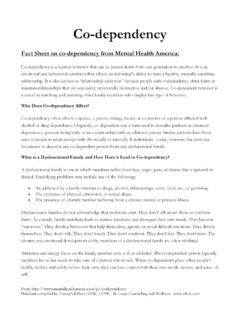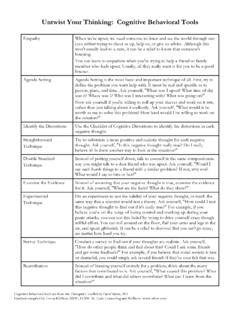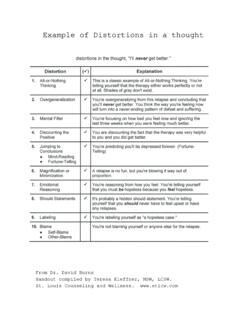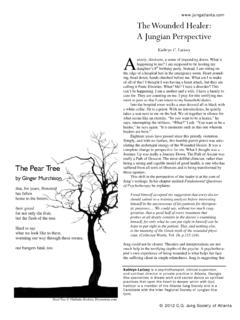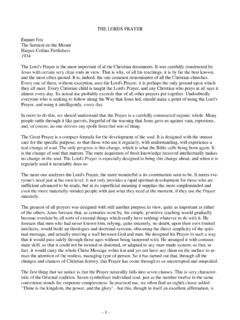Transcription of Carolyn Myss on Archetypes - stlcw.com
1 Information from Carolyn myss . Handout compiled by Teresa Kleffner, MSW, LCSW. St. Louis Counseling and Wellness. Archetypes Carolyn myss on Archetypes : Most Archetypes are psychological patterns derived from historical roles in life, such as the mother, child, trickster, servant; they can also be universal events or situations, such as initiation, death and rebirth. Along with our individual personal unconscious, which is unique to each of us, Jung believed that there exists a second psychic system of a collective, universal, and impersonal nature that is identical in all individuals.
2 The collective unconscious, as he called it, is inherited rather than developed and is composed largely of Archetypes and mythological figure. Although Archetypes are both ancient and universal, they become personalized when they re a part of your own psyche. Archetypes are not passive entities floating around in the psyche like old family portraits hanging in a dusty castle. They take an active role as guardians and inner allies, awakening you when you re in danger of falling into destructive behavior. The saboteur, for instance, comes into play when you re in a situation in which you tend to sabotage your best interests or allow others to sabotage you.
3 When you learn to recognize such a pattern, instead of ignoring it or denying its presence, it becomes your friend and helper. All Archetypes have shadow manifestations as well as positive aspects. The rebel can be a powerful force leading you to reject illegitimate authority and strike out on a bold new path of action. But if you let your awareness lapse, its shadow aspect can induce you to rebel against constructive, positive leaders, or to fall in love with the image and trappings of rebellion. Exercise to do with your Archetypes : 1. Pay attention to which Archetypes are present for you and name them.
4 Use the attached list or make up your own. 2. Ask them what they have to say about the situation. 3. Explore what the emotions are behind their statements. Name those too. 4. When you deny someone s reality they will become more entrenched in it. Do not deny or argue with their statements or emotions. 5. The archetype is there trying to protect you in some way. 6. Reassure them. What can you say to them to reassure their feelings? Reassurance is not about agreeing. It is about validating the archetype s perspective. Information from Carolyn myss . Handout compiled by Teresa Kleffner, MSW, LCSW.
5 St. Louis Counseling and Wellness. Archetype Examples The Victim While the label victim has negative connotations, in its healthy state, this archetype provides a quality of perception and strength that protects against victimization from others. It alerts us to become more conscious in situations that are conducive to being taken advantage of. In its underdeveloped state, the victim feels that it is always taken advantage of, and never at fault. The purpose of the Victim is to teach us how to develop the courage and strength to stand up for oneself and to no longer invite victimization in.
6 We are not meant to be victimized in life, but are meant to learn how to face our challenges and overcome them. The Saboteur (The Guide, The Protector, The Facilitator) This archetype often is the most difficult to comprehend as it is associated with the concept of betrayal. In truth, the purpose of this archetype is to help you learn the many ways in which you challenge, or sabotage, yourself. Our fears frequently cloud the quality of our decisions. There are numerous examples of cases in which the underdeveloped saboteur surfaces. We begin a new relationship and then destroy it because we are afraid of a painful outcome.
7 We begin a working relationship and find ourselves in a power struggle when we fear the talents of the other person. The developed Saboteur guards self, home and everything else important. It guides us in and out of situations by allowing us to feel incredibly creative and vulnerable at the same time. The combination of these two energies activates our potential to rise out of self-destruction. Once maturity is accomplished, the Saboteur becomes an ally that alerts us when we are in a vulnerable state, and thereby allows us to consciously exercise empowered choice. The Prostitute The term Prostitute also implies a negative meaning, but we learn from this archetype not to compromise or sacrifice our mind, body, or spirit.
8 Prostitution takes many forms that all include compromising one s morals or ethics, sacrificing any aspect or expression of yourself. For example, have you ever "sold out" to people or organizations that you did believe in? Have you remained in a bad marriage for financial protection, put someone else in a compromising position in order to gain power, or bribed another for loyalty, support or silence? Have you ever judged as weak those who continually compromise themselves? These examples represent the negative energy of this archetype. Yet, in the case of the developed prostitute, one engages in lessons of integrity and dignity that allows one to refuse sacrificing any expression of the self.
9 The Actor/Storyteller The Actor/Storyteller brings pleasure to all by acting out events in life, and shares lifelong wisdom and insight through story, myth, and legend. The shadow, or the underdeveloped side of the Actor has a need to exaggerate the drama of his or her own life by telling untrue stories, including everything from gossip to attempts to defame another person in the public eye. When living the dark side of this archetype, we might find ourselves as the recipient of our own falsehoods, or living out the legend of the "Boy Who Cried Wolf," so that no matter what we say, others no longer accept it as truth.
10 Characteristics of this energy include exaggerating, dramatizing, attention seeking behavior, fabricating information, and lying. The Artist This archetype is associated with aesthetic creativity. It plays a dominant role in those skilled in the fine arts such as literature, poetry, music, painting and photography. The artist is often a social voice or visionary, representing the energy of the human conditions through his/her particular talent. The shadow side of this archetype believes that in order to achieve success great suffrage and psychological pain is required as a type of initiation; there is little hope to be recognized until after death.
